Evolution:Back to the future to understand and control prostate cancer
Donald S.Coffey
Perspectives
Evolution:Back to the future to understand and control prostate cancer
Donald S.Coffey
Brady Urological Institute,The Johns Hopkins Hospital,Baltimore,MD,USA
Received 28 August 2014;accepted 6 September 2014
Available online 16 September 2014
1.Introduction
I am most honored to be asked to contribute to the Asian Journal of Urology(AJU).For many years Asian urologists and investigators have provided major contributions to Urology.I applaud and salute this great moment.This new Journal will serve the world in so many unique ways,and we are proud to be part of this most historical moment.
In 2015,the Brady Urological Institute at Johns Hopkins will celebrate its 100 year anniversary.For half of that century,I was privileged to be the Research Director.I am now82 years of age,and very excited to have been replaced by the talented Dr Kenneth Pienta.He has been our new leader for several years and joins me in saluting you.
The new AJU will provide a fresh forum for urological studies originating in Asia as well as the international urology community.This Journal will most certainly provide a much needed new perspective to the field of Urology.With this perspective in view,I hope I might in some way serve this new Journal.I will try to sum up a few of my observations and experiences collected over my 50 years of research focused on the prostate.I will present here only 12 points.Many of the more senior leaders and readers will already know them well.I hope that these few observations may serve as clues to challenge new and young investigators working on “The Riddle of Cancer.” Almost one out of four people on this planet will suffer from this most devastating disease.Many will have a urological form of cancer.We need far more progress.This goal deserves our best efforts and we must work even more closely together.The AJU will be a major beacon in this effort.I am a bit old to be a good guide but I am honored to join your march.
I highlight below many of my thoughts only for emphasis and hopefully will help guiding our future understanding of cancer through new discoveries.
2.Question 1:Of the thousands of mammalian species on earth,none will develop lethal prostate cancers with advanced age except for humans and dogs.Why might this be so?
It appears that the dog and human markedly changed their diets and activity over the course of evolution as they came together in ancient tribes and early villages.Ancient humans markedly changed their life style with farming,herding,animal domestication,cooking,and preserving meat by salting and smoking.This was combined with a far more sedentary life.All of this first occurred only about15,000 years ago over the last 7%of homosapiens history of 200,000 years.All of these new human life style changes are now known to be important factors clearly associated with increased cancer incidence.These include obesity,lack of activity,smoking,inflammation,burning meat,and many known and unknown carcinogens.The domesticated dog shared much of the early human environment and this included diet and life style.In addition the dog shows a unique synergism in combining estrogens with dihydrotestosterone(DHT)which markedly increases abnormal prostate growth[1].It is important to note that only the humanand dog also suffer from benign prostate hyperplasia(BPH)[2e4].In both species prostatic inflammation is also prominent.
3.Question 2:In humans,what causes the tremendous difference in the organ specificity of human cancer for the prostate and not for the seminal vesicles?
In the United States there is a million fold difference in lifetime mortality risk between prostate cancer and seminal vesicle cancer(Fig.1).In the United States 3%of all living males will ultimately die from prostate cancer.This totals over 4 million men at risk.In comparison,less than 10 men will die from primary seminal vesicle cancer.This is in spite of many similarities shared between the prostate and seminal vesicle gland including inheritance,environment,diet,life style,aging,blood androgen levels and other shared biological factors(Table 1).Several differences could be involved:(1)Animals like the dog that eat meat do not have seminal vesicles.The exception is the human who has a seminal vesicle and eats meat,but as mentioned the human diet changed remarkably during evolution.(2)The prostate,but not the seminal vesicles,is associated with inflammation that could damage the DNA[5].Most importantly,Dr Marikki Laiho at Hopkins has many classical papers reporting marked differences in the DNA repair mechanisms between the two glands that favors DNA repair in the seminal vesicles[6,7].
4.Question 3:If evolution drives all life forms,and cancer is reported to be a reactivation of evolution from an adult somatic cell,then how does this work?(We don’t really understand all aspects of evolution at the molecular level,particularly the phase shifts and reactivation.)
Brief overview of evolution:All of the many animal and plant species and life forms on earth,including all 100 trillion cells in our bodies,as well as all cancer cells,originated at one time from the same singularity,one ancient cell that formed about 3.9 billion years ago.This was the first and last cell common to all life.
Much later only 7 million years ago,apes,chimps and our earliest primate descendants all had a common ancestor,and then they separated as new species.All modern humans,Homosapiens,originated only about 200 thousand years ago in Africa,and then spread rapidly across the planet.The most ancient dynasties are all far less than 15,000 years old.
We are all out of Africa and related in some manner and the DNA shows it, butwhat a complex genetic mixture we are.We all know that each of the many breedings of our ancestors combined two selected germ cells to fertilize into a zygote,where no two germ cells have been alike in each donor pool because of the extensive multiple crosses between the meiotic chromatids. The specificity is that most genes come in pairs.There is another DNA specificity in that our mitochondrial DNA can only be inherited from the mother.In contrast,the Y chromosome DNA and the X chromosome are only single copy in the male and in the prostate.This is a complex DNA pool in humans.Even siblings can be very different.
Evolution involves sex to combine two germ cells that provide embryos that develop for 9 months,and this provides an internal selection process that is like evolution.This development and pregnancy selection,if successful,can produce a surviving live birth.The helpless infant must be protected and nurtured for a dozen years before it can mature,breed and produce viable off spring.Evolution thus occurs at many levels.
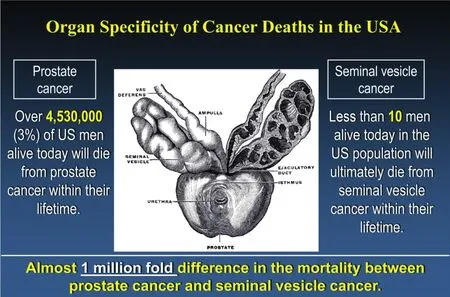
Figure 1 Of the entire population of males living today within the United States,3%will ultimately die from lethal prostate cancer within their lifetime.This would calculate to a value of 4.35 million with a lifetime risk of dying from this cancer.This risk increases markedly with aging and as life expectancy increases,so will these total deaths increase.In comparison,death from primary seminal vesicles cancer is an extremely rare event with very few primary cases ever being reported in the world literature.It is safe to state that less than 100 primary cancer cases have been reported[6].In contrast,many secondary metastases to the seminal vesicles commonly occur from prostate and bladder cancer cell invasions.This demonstrates that other types of cancer cells can invade,survive,and grow within the seminal vesicles[6].
Somatic cells are NOT directly involved in this evolutionary process.An exception is the immune cells,special somatic cells that recapitulate and mimic some part of the evolutionary process by producing genetically variable clones that are selected and expanded.In some cases immune cells move through the body and attack normal cells,known as autoimmunity.
Cancer is also a recapitulation of some elements of evolution in that a single somatic cell develops genetic instability leading to tumor cell heterogeneity and biodiversity that selects clones to survive.The metastatic cell can destroy the host.No sex or meiosis is involved,but it must inherit the host nucleus and mitochondria.
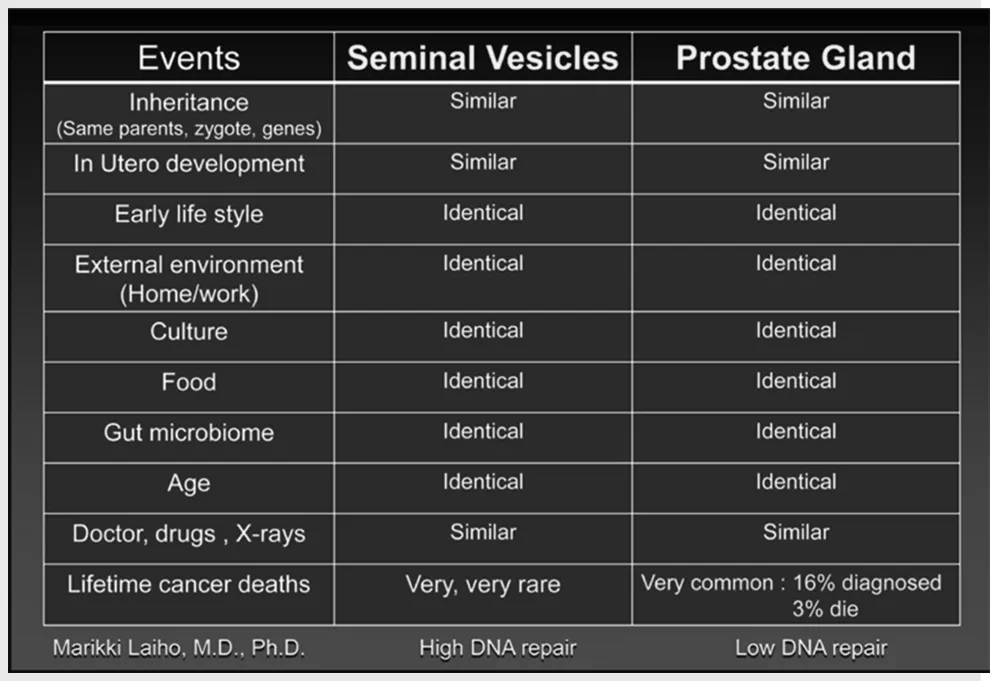
Table 1 The most scholarly review and classical research reported on the comparison of the marked difference between the incidence of cancer in the seminal vesicles and prostate comes from the laboratory of Dr Marikki Laiho[6].The difference appears to implicate the types of development and epigenetic differences that alter DNA damage and DNA repair.
5.Question 4:Why don’t identical twins get identical cancers?
The answer may be that identical twins don’t have identical DNA,even though they came from the same zygote.Less than 2%of the total DNA sequence is contained within genes that can be translated into proteins.The great bulk of the DNA sequence is in repetitive elements and over 30%of the sequence is in some form of ancient transposons that can move around within the genome.These repetitive elements and transposons are just being sequenced and their function is just being revealed.
In addition,all of the DNA is constantly undergoing local repair to correct errors as are the many types of RNA that are being edited,folded and spliced.
Epigenetic control of DNA expression and RNA function is now apparent.Epigenetics is driven in part by the methylation of DNA which can be both inherited and transient.Though one identical twin gets prostate cancer,60%of monozygotic identical twins will NOT get lethal prostate cancer.It is now certain that IDENTICAL TWINS DO NOT HAVE IDENTICAL DNA.The explanation for this difference observed in identical twins limits how we analyze our genetic information for the individual,and helps explain why they don’t share identical types of cancers too often.
Recentinformation shows that NO TWO CELLS SEQUENCED FROM AN INDIVIDUAL CANCER ARE ALIKE IN THEIR GENOTYPE,OR PHENOTYPE!
6.Question 5:Can we develop a DNA barcode for prostate cancer that predicts lethal disease early enough to effectively treat it?
We are now riding on a growing tsunami of digitized information that is flooding the senses of both the physician and patient.Can it be simplified,understood,and managed in a quick manner?Yes!To better understand information transfer refer to the definitive review in the book:The Information by James Gleick[8].
The average supermarket has about 25,000 store items,and your cells have about 25,000 genes.The information in store for each item is contained on a one inch barcode with about 30 different bars.Each bar is selected from a variety of 10 different bar widths(representing the numbers 0e9).The available combinations of numbers from these barcodes are therefore 10 to the 30th power(a number equal to[10 billion?10 billion?10 billion]).This total possible number combinations that could be represented by the simple store barcode is so massive it could potentially code for any conceivable item that will ever be made on this earth,with millions of information features on each of the individual items.Today,with this simple store barcode,we can process individual information on each item in only a fraction of a second.This happens every day at any common checkout counter.
The same technique is now in place for a DNA barcode.The DNA in each cell is two meters in length and contains a four code system(ATGC)and has 3 billion base pair bars in each cell.Compared to the 30 bars in the store barcode,this would be enough information to code for 4 to the 3 billionth power.This is far too much information to ever be conceived.Can the DNA barcode be simplified?Read on.
There is now a BARCODE OF LIFE(Fig.2)that will identify any of the millions of different animal species on this planet earth,by just scanning the order of ATGC nucleotides in a very minute fragment of DNA that is just composed of a total of only 17 nucleotides[7]!!This special gene that contains this special 17 nucleotide fragment is found within the mitochondrial gene that codes for CO-1,an abbreviation for CYTOCHROME OXIDASE complex-1.This CO-1 enzyme is essential to animals that get their energy from mitochondria.The CO-1 is not in land plants that use chlorophyll instead of mitochondria.Land plants and bacteria have their own special barcode of DNA.
Dr John Petros,a urologist at Emory University in Atlanta,Georgia,has been a major leader in studying mitochondrial DNA in urological samples[9].
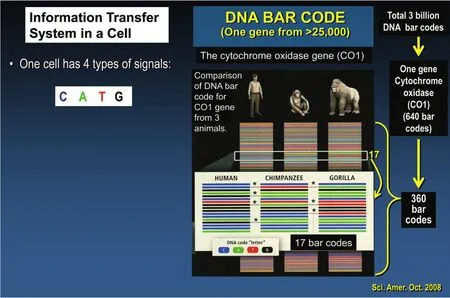
Figure 2 The sequence of the cytochrome oxidase CO-1 gene in a region of only 17 nucleotides is sufficient to identify the vast number of animal species on the earth.This is one of the BARCODES OF LIFE(see this figure and discussion in the October,2008 issue of Scientific America).
The goal now is to develop a barcode for lethal prostate cancer that can be detected in small DNA fragments in the blood or in non-invasive liquid biopsies from the urine or semen.It is easily applied to individual cells in the blood like circulating tumor cells(CTCs).
It is hoped it will be possible to detect lethal prostate cancer very early by a “field effect” outside the tumor areas seen by the pathologist(Fig.3).
7.Question 6:Can high throughput pathology detect lethal cancer in prostate samples that look “normal” to present day pathologists?
This has been reported by using quantitative nuclear morphology by Dr Peter Gann[10],and see review by Dr Robert Veltri[11].Other techniques have applied a very high resolution light microscope using back reflection,andhave firmly established a “field effect” in breast cancer samples[12].Flow cytometry on aspirated live cells is promising[13]as is laser and immunohistochemistry on CTCs[14].
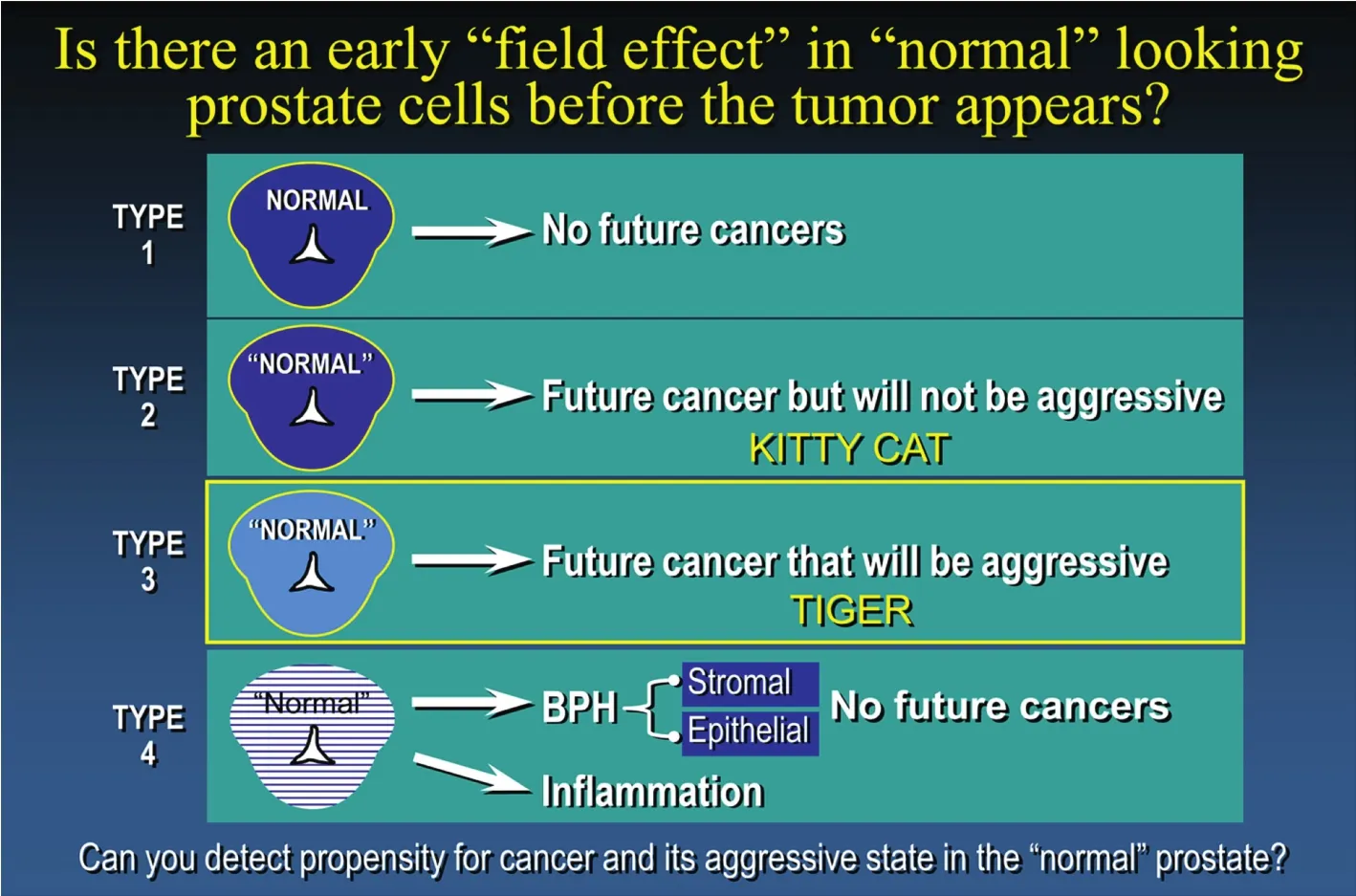
Figure 3 It is now apparent that many types of prostate cancers will never progress to a state that will be lethal(termed here“Kitty Cats”).In contrast,some forms of prostate are very aggressive and will later be lethal(termed “Tigers”).Are there very early field changes in a normal appearing prostate gland that can predict that it will later develop into the Tiger Cancer(Type 3)?There is growing evidence that this may be possible.
Dr Leland W.K.Chung and his colleagues have developed special in vivo dyes that provide fluorescence in the nearinfrared fluorescence spectra and can detect live tumors by external non-invasive imaging methods[15,16].
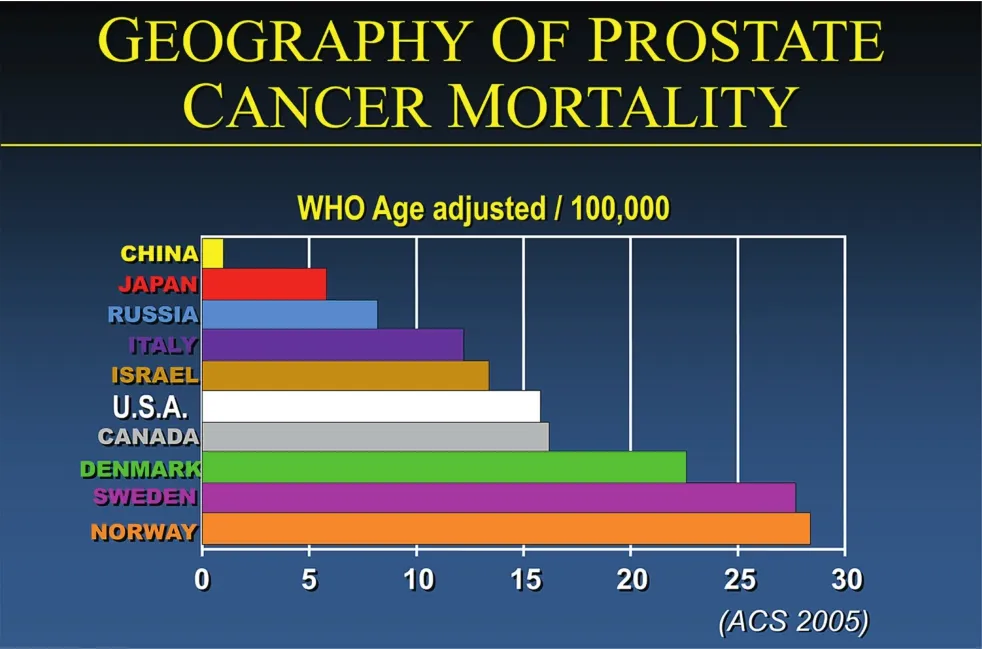
Figure 4 Cancer mortality rates vary with time in different countries.They also vary within locations in each country and by life style.Since rates change as people move to different localities,it provides a possibility of informative epidemiological studies to reveal causative factors.The data here are for 2005 to capture more complete WHO data provided then through the ACS.
8.Question 7:Prostate cancer is specific for the country you live in,and when you move your risk adjusts to that of the country you move to(Fig.4).Why?Prostate cancer seems to be related to a western diet.Why?can we find the risk factor(s)and can this information be used to prevent cancer?
It appears that life style trumps genetic inheritance.Stress,what you eat,how you prepare the food,and the inflammation within the prostate are critical factors related to prostate cancer[17].Prostate inflammation from reactive oxygen or pathogens is an early step in carcinogenesis[17,18].In animal models prostate inflammation is prevented by soy in the diet[19].The microbiome in the gut influences the active soy metabolism to phytoestrogens(gentisen)in the intestines(See Fig.4).
The largest and longest epidemiological study in humans only shows one dietary factor with a strong association,CHOLINE[20].Choline is an essential nutrient in the diet and is a major one carbon donor to provide the methyl donor to S-adenosyl methionine(SAM).SAM provides the critical component for methylating DNA,RNA,and proteins in many epigenetic events in the body.Dietary choline is a major step in synthesis of lipids through the essential CDPCholine building block.Choline is involved via SAM as the critical factor in DNA synthesis through nucleotide conversion of uridine to form thymidine by methylation.Choline also provides methyl groups for the epigenetic modification events in the cell.For all these reasons,choline is markedly elevated in many types of cancer as can be seen by MRI spectra.Therefore,choline is a sensitive PET scanning agent for metastatic lesions.Since choline is an essential dietary component and is keyed to cancer,it merits our attention as a life style factor in cancer.
Other dietary factors involve how overheating meats to produce the common charcoalstripesintroducesa polycyclic carcinogen that when fed to rats induces cancerof the prostate,breast,orcolon but not seminal vesicles[21].

Figure 5 Individual units within a system act in a collective manner to self-organize into a new module(e.g.flock,city,neurons,bacteria,and cancer).This emergent module is highly adaptive and exhibits dynamic plasticity.The communication is essential,it has no leader,and it is a complex adaptive system like an ant hill that comes from one clone.
9.Question 8:Cancers have collective properties and communication between cancer cells and host cells.How?
Collective communication and self-organization are most apparent in ant hills,bee hives,and bacterial colonies(Fig.5).It extends to schools of fish,flocks of birds and cities as well as non-animate systems like snowflakes[22].This is paramount for group survival and in the case of how bacteria increases resistance to drugs and stress.Many fragments of DNA and many types of exosomes and noncoding RNAs are involved.Early leaders in this field are Leland W.K.Chung[23,24],Ken Pienta[25,26],Eschel Ben-Jacob[27,28]and others.TO STOP COLLECTIVE COMMUNICATION IN CANCER WE NEED A CYBER WAR.
10.Question 9:Normal prostates have inherent homeostasis and with androgen they grow to a predetermined size and stop growth(Fig.6)
No normal prostate in humans or animals becomes castrate resistant and never regrows in the absence of the testes(See Fig.6).
The opposite to the above statements occurs in prostate cancer where there is no limit on androgen induced growth and most prostate cancers become resistant to castration therapy.
(See review by Dr.Donald Tindall on androgen action[29]).
11.Question 10:All factors in normal cells are ordered by homeostasis.The opposite is true in cancer cells where everything is varied(Fig.7)
To destroy the last cancer cell may be difficult.It may be better to put it on “PAUSE”by changing its habitat[32,33].This is what we do to control bacteria and weeds growing in our lawns(See Fig.7).

Figure 6 This is a study of homeostasis in a normal rat ventral prostate gland.The total DNA represents the total cells.Normal is far left in time and following castration,the gland shrinks with loss of DNA and cells.The restoration of testosterone turns on DNA synthesis and restores the gland.Then even with androgen and receptor,it turns back off when homeostasis is reached[30].This homeostasis does not occur in prostate cancer.
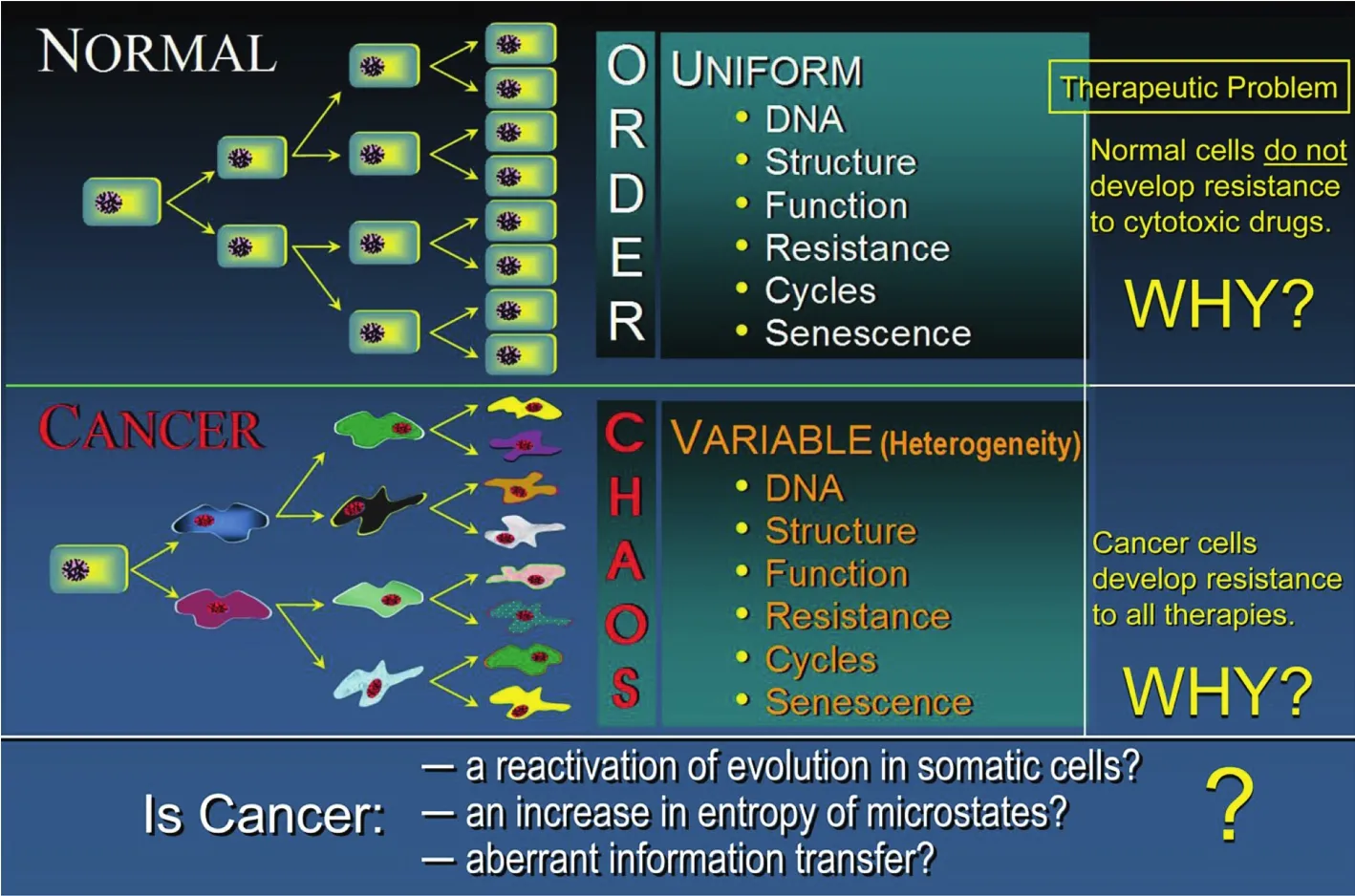
Figure 7 Theoretical differences of how normal cells responded differently from cancer cells and their ability to gain therapeutic resistance.The chaotic cancer cells acquired ability to activate somatic cells,increase to entropy to develop micrometastasis and aberrant information transformed not normally seen in normal cells[22,31].
It may be possible to pasteurize the cancer cells and preserve the normal cells.We don’t kill all the bacteria in the grocery store and food supply,and yet we make it edible.We should study how this is done and extend it to cancer control.
12.Question 11:We may have to control cancer by fighting evolution with synthetic evolution.This means using a random library
This means letting the cancer select its own drug by using a random library of synthetic RNA aptamers[34,35].With each binding from the library you enrich the homing aptamer to be amplified for the next round of amplification and purification.This process is called SELEX.We suggest it might be effective in controlling tumor cell heterogeneity and resistant cells.Dr Shawn Lupoldhas made a very effective aptamer against a PSMA target on the human prostate cancer cell surface[36].He has now constructed a hybrid to knock out the DNA repair enzymes.
13.Question 12:Don’t wait on the computer
The largest supercomputers can store as much information as your brain and can process it at the same speed.To do this it requires 10 million W.Your brain can do the same calculations on only 20 W.
Read the paper titled“The Real Final Exam”[37]and join this most important project.
Thank you and I wish you all the best of luck.
Conflicts of interest
The author declares no conflict of interest.
[1]DeMarzo AM,Coffey DS,Nelson WG.New concepts in tissue specificity for prostate cancer and benign prostatic hyperplasia.Urology 1999;53:29e39.
[2]Coffey DS.Similarities of prostate and breast cancer:evolution,diet and estrogens.Urology 2001;57:31e8.
[3]Coffey DS,Walsh PC.Clinical and experimental studies of benign prostatic hyperplasia.Urol Clin North Am 1990;17:461e75.
[4]Prins GS,Jung MH,Vellanoweth RL,Chatterjee B,Roy AK.Age-dependent expression of the androgen receptor gene in the prostate and its implication in glandular differentiation and hyperplasia.Dev Genet 1996;18:99e106.
[5]De Marzo AM,Platz EA,Sutcliffe S,Xu J,Gr?nberg H,Drake CG,et al.Inflammation in prostate carcinogenesis.Nat Rev Cancer 2007;7:256e69.
[6]J??maa S,Laiho M.Maintenance of genomic integrity after DNA double strand breaks in the human prostate and seminal vesicle epithelium:the best and the worst.Mol Oncol 2012;6:473e83.
[7]Stoeckle MY,Hebert PD.Barcode of life.Sci Am 2008;299:82e6.
[8]Gleick J.The information.New York,NY:Pantheon Books;2011.
[9]Scott TA,Arnold R,Petros JA.Mitochondrial cytochrome c oxidase subunit 1 sequence variation in prostate cancer.Cairo:Scientifica;2012.p.701810.
[10]Gann PH,Deaton R,Amatya A,Mohnani M,Rueter EE,Yang Y,et al.Development of a nuclear morphometic signature for prostate cancer risk in negative biopsies.PLoS One 2013;8:e9457.
[11]Veltri RW,Christudass CS.Nuclear morphometry,epigenetic changes and clinical relevance in prostate cancer.Adv Exp Med Biol 2014;773:77e99.
[12]Bista RK,Wang P,Bhargava R,Uttam S,Hartman DJ,Brand RE,et al.Nuclear nano-morphology markers of histologically normal cells detect the “field effect” of breast cancer.Breast Cancer Res Treat 2012;135:115e24.
[13]Benson MC,Walsh PC.The application of flow cytometry to the assessment of tumor cell heterogeneity and the grading of human prostatic cancer:preliminary results.J Urol 1986;135:1194e8.
[14]Lowes LE,Goodale D,Keeney M,Allan AL.Image cytometry analysis of circulating tumor cells.Methods Cell Biol 2011;102:261e90.
[15]Yang X,Shi C,Toing R,Qian W,Zhau HE,Want R,et al.Near IR heptamethine cyanine dye-mediated cancer imaging.Clin Cancer Res 2010;16:2833e44.
[16]Yang X,Shao C,Wang R,Chu CY,Hu P,Master V,et al.Optical imaging of kidney cancer with novel near infrared heptamethine carbocyanine fluorescent dyes.J Urol 2013;189:702e10.
[17]Shinohara DB,Vaghasia AM,Yu SH,Mak TN,Brüggeman H,Nelson WG,et al.A mouse model of chronic prostatic inflammation using a human prostate cancer-derived isolate of Propionibacterium acnes.Prostate 2013;73:1007e15.
[18]Nelson WG,DeMarzo AM,Yegnasubramanian S.The diet as a cause of human prostate cancer.Cancer Treat Res 2014;159:51e68.
[19]Sharma OP,Adlercreutz H,Strandberg JD,Zirkin BR,Coffey DS,Ewing LL.Soy of dietary source play a preventive role against the pathogenesis of prostatitis in rats.J Steroid Biochem Mol Biol 1992;43:557e64.
[20]Richman EL,Kenfield SA,Stampfer MJ,Giovannucci EL,Zeisel SH,Willett WC,et al.Choline intake and risk of lethal prostate cancer:incidence and survival.Am J Clin Nutr 2012;96:855e63.
[21]Nakai Y,Nelson WG,De Marzo AM.The dietary charred meat carcinogen 2-amino-1-methyl-6-phenylimidazo[4,5-b]pyridine acts as both a tumor initiator and promoter in the rat ventral prostate.Cancer Res 2007;67:1378e84.
[22]Coffey DS.Self-organization,complexity and chaos:the new biology for medicine.Nat Med 1998;4:882e5.
[23]Chu GC,Chung LW.RANK-mediated signaling network and cancer metastasis.Cancer Metastasis Rev 2014;33(2e3):497e509.
[24]Morello M,Minciacchi VR,de Candia P,Yang J,Posadas E,Kim H,et al.Large oncosomes mediate intercellular transfer of functional microRNA.Cell Cycle 2013;12:3526e36.
[25]Camacho DF,Pienta KJ.Disrupting the networks of cancer.Clin Cancer Res 2012;18:2801e8.
[26]Camacho DF,Pienta KJ.A multi-targeted approach to treating bone metastases.Cancer Metastasis Rev2014;33(2e3):545e53.
[27]Ben-Jacob E,Coffey DS,Levine H.Bacterial survival strategies suggest rethinking cancer cooperativity.Trends Microbiol 2012;20:403e10.
[28]Lu M,Jolly MK,Levine H,Onuchic JN,Ben-Jacob E.Micro-RNA based regulation of epithelial-hybrid-mesenchymalfate determination.Proc Natl Acad Sci U S A 2013;110:18144e9.
[29]Schmidt LJ,Tindall DJ.Androgen recetor:past,present and future.Curr Drug Targets 2013;14:401e7.
[30]Coffey DS,Shimazaki J,Williams-Ashman HG.Polymerization of deoxyribonucleotides in relation to androgen-induced prostatic growth.Arch Biochem Biophys 1968;124:184e98.
[31]Takaha N,Hawkins AL,Griffin CA,Isaacs WB,Coffey DS.High mobility group protein I(Y):a candidate architectural protein for chromosomal rearrangements in prostate cancer cells.Cancer Res 2002;62:647e51.
[32]Getzenberg RG,Coffey DS.Changing the energy habitat of the cancer cell in order to impact therapeutic resistance.Mol Pharmacol 2011;8:2089e93.
[33]Garcia-Schurmann M,Coffey DS.The concept of evolution in the pathogenesis and treatment of prostate cancer.Br J Urol 1997;79(Suppl.2):9e17.
[34]Lupold SE,Hicke BJ,Lin Y,Coffey DS.Identification and characterization of nuclease-stabilized RNA molecules that bind human prostate cancer cells via the prostate-specific membrane antigen.Cancer Res 2002;62:4029e33.
[35]Ni X,Castanares M,Mukherjee A,Lupold SE.Nucleic acid aptamers:clinical applications and promising new horizons.Curr Med Chem 2011;18:4206e14.
[36]Ni X,Zhang Y,Ribas J,Chowdhury WH,Castanares M,Zhang Z,et al.Prostate-targeted radiosensitization via aptamer-shRNA chimeras in human tumor xenografts.J Clin Invest 2011;121:2383e90.
[37]Coffey DS.The real final exam.Prostate 1999;39:323e5.
E-mail address:dcoffey@jhmi.edu.
Peer review under responsibility of Chinese Urological Association and SMMU.
http://dx.doi.org/10.1016/j.ajur.2014.09.007
2214-3882/a2014 Editorial Office of Asian Journal of Urology.Production and hosting by Elsevier(Singapore)Pte Ltd.This is an open access article under the CC BY-NC-ND license(http://creativecommons.org/licenses/by-nc-nd/4.0/).
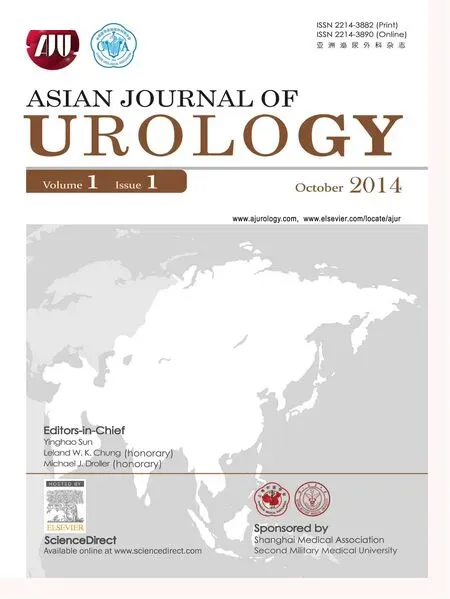 Asian Journal of Urology2014年1期
Asian Journal of Urology2014年1期
- Asian Journal of Urology的其它文章
- Systematic evaluation of a holmium:yttrium-aluminum-garnet laser lithotripsy device with variable pulse peak power and pulse duration
- Robotic assisted laparoscopic simple suprapubic prostatectomy e The Smith Institute for Urology experience with an evolving technique
- Current trends in urethral stricture management
- Novel anti-androgen receptor signaling agents:Understanding the mechanisms of resistance
- Prostate cancer in Asia:A collaborative report
- Comment on the discovery of prostate specific antigen
